A Closer Look at China’s Missile Silo Construction

What’s underneath the shelters over China’s suspected silo construction sites? Image © 2021 Maxar Technologies
[Update: Some images have temporarily been taker down because Maxar does not allow their satellite images to be overlaid on a competitor’s image.] After the discovery during the summer of what appears to be at least three vast missile silo fields under construction near Yumen, Hami, and Ordos in north-central China, new commercial satellite images show significant progress at the three sites as well as at the People’s Liberation Army Rocket Force (PLARF)’s training site near Jilantai.
The images provide a vivid and rare public look into what is otherwise a top-secret and highly sensitive construction program. The Chinese government has still not officially confirmed or denied that the facilities under construction are silos intended for missiles and there are many uncertainties and unknowns about the nature and role of the facilities. In this article we use words like suspected, apparent, and probable to remind the reader of that fact.
Yet our analysis of hundreds of satellite images over the past three years of the suspected missile silo fields and the different facilities that are under construction at each of them have increased our confidence that they are indeed related to the PLARF’s modernization program. In recent analysis of new satellite images obtained from Planet Labs and Maxar Technologies, we have observed almost weekly progress in construction of suspected silos as well as discovered unique facilities that appear intended to support missile operations once the silo fields become operational.
In this article we describe the progress we have observed. We first describe the shelters, then what we see under the shelters, unique support facilities, and end with overall observations.
Shelter Features and Activities
Some of the most visible features at each of China’s newly-discovered probable missile silo fields are the environmental shelters that cover each suspected silo headworks. It was these structures, first seen at Jilantai, that led to the discovery of the three large suspected missile silo fields. Shelters are not new phenomena in Chinese missile construction; declassified reports from the US National Photographic Interpretation Center suggest that in the 1970s and 1980s China used a mixture of “large rectangular covers,” “camouflage nets,” and other types of shelters to protect its silos from the elements, as well as from spy satellites above.
The construction progression typically goes like this: a space for each silo headworks is cleared, then the shelter is erected before large-scale excavation begins. Occasionally the silo hole – or part of it – is excavated first and the shelter is erected over it before the silo components are installed. Several satellite images show semi-circle structural forms that may be lowered into the hole and assembled to form the silo walls during this phase. Several months later, the shelter is removed, and construction continues in the open-air with less sensitive auxiliary structures.
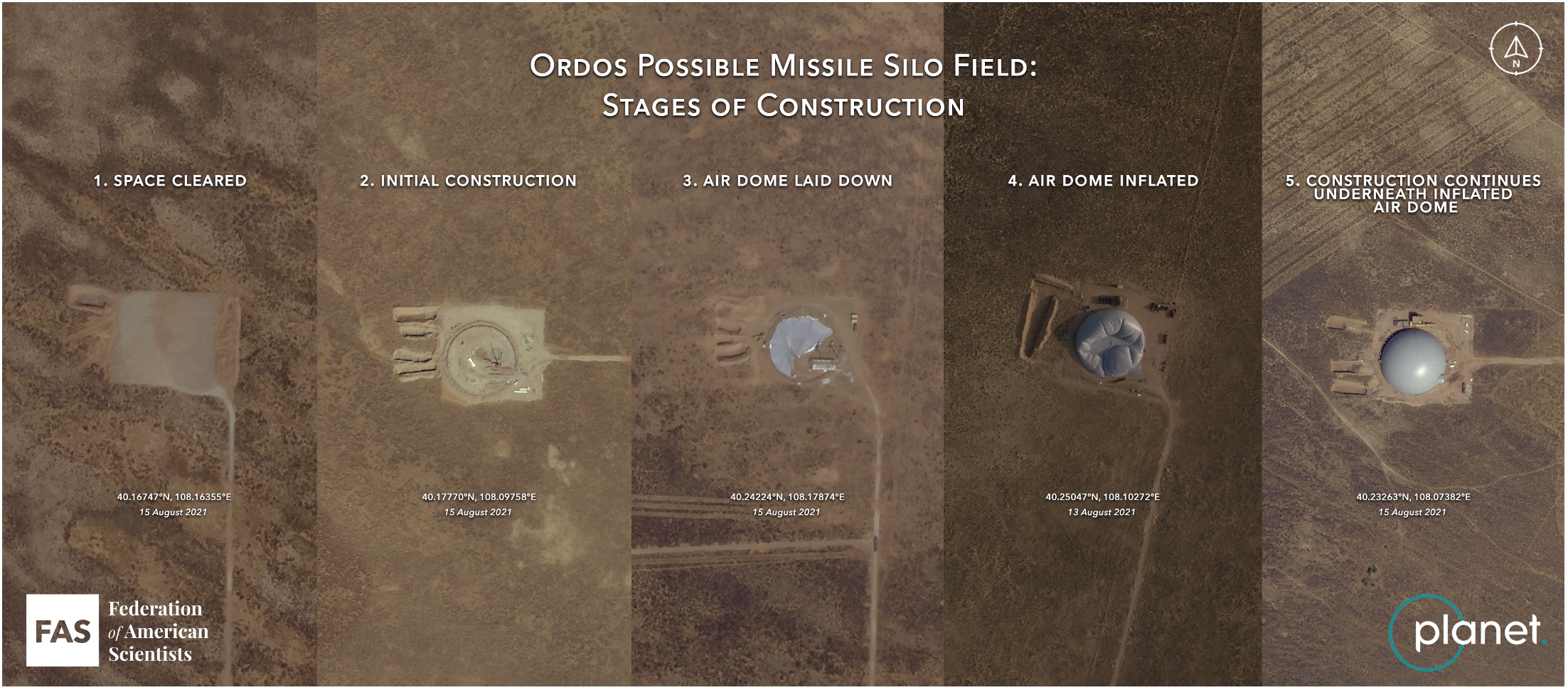
Suspected missile silos near Ordos at different stages of construction. Images © 2021 Planet Labs.
Apart from hiding silo details from satellites, these environmental shelters play an important role in the construction process: winter temperatures in areas like the Jilantai training area can reach below -25 degrees Celsius and pouring concrete in cold temperatures can cause it to freeze and crack. Additionally, many of China’s suspected silo sites are located in desert areas with periodic sandstorms. Spring floods are another challenge, so many silo sites and roads are elevated above the ground level and often with barriers or tunnels to prevent water damage. Environmental shelters, therefore, help keep construction running smoothly and on schedule year round, and they can be erected and dismantled in just a couple of days.
Interestingly, China appears to be experimenting with several different types of shelters for each of its suspected silo fields. The reason for this may have to do with practical construction issues rather than what is being constructed under them.
- Short Rectangular Shelters
The most common shelter visible at China’s suspected silo complexes is a rectangular dome-like structure very similar to those used at indoor tennis courts or soccer pitches. Each structure appears to be air-inflated with an estimated area of 4,125 square meters, and must be accessed through a series of airlocks––one for pedestrians and an extended one for vehicles. The external ventilation system provides climate control and a slight continuous overpressure inside the dome, allowing it to retain its rounded shape. See example of inflatable shelter.
Identical rectangular air domes are visible at the Jilantai missile training area, the suspected Yumen silo site, and the suspected Hami silo site. While this does not necessarily prove that identical construction is taking place underneath each dome, it does imply a connection of the activities at the three sites.
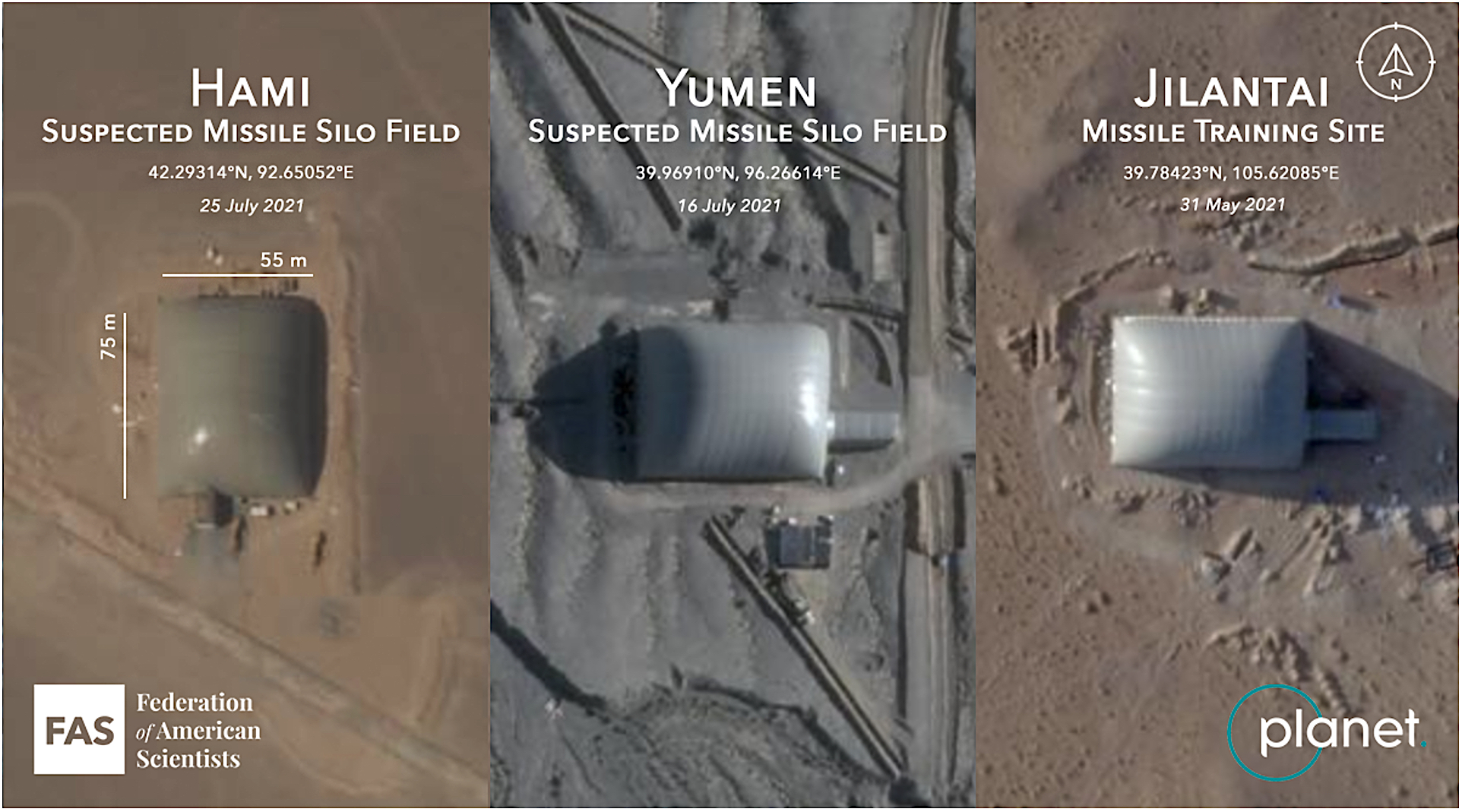
Identical shelter domes seen at Hami, Yumen, and Jilantai. Images © Planet Labs.
In July 2021, Capella Space––a satellite company specializing in synthetic aperture radar––imaged one of the domes at the Yumen site. The SAR image allowed analysts to see the outlines of some structures underneath the dome, although it is difficult to discern much from the image except the clearly-visible framework of the external airlock. There appears to be significant activity directly in the center of the dome, which is where the suspected silo hole appears to be located.
- Long Rectangular Shelters
At the suspected Hami silo field, we see deployment of a slightly longer variant of the regular dome shelter. The Hami site is at a later stage of development than its counterpart at Yumen. The structures measure approximately 20 meters longer than the aforementioned domes erected at Yumen and Jilantai, but otherwise appear to be very similar. One discernible difference between the two is that the vehicle airlock is not extended outside of the dome’s main structure but appears to be embedded within the dome itself.
Although the suspected silo site at Hami contains both types of inflatable domes, there are now more of the longer variant than the shorter version. Given that Hami is a newer site than both Yumen and Jilantai, it is possible that construction has now switched entirely to the longer version and will continue to use this structure for future sites. While Yumen does not appear to have any longer domes on-site, it is notable that some crude extensions to its shorter domes were erected there. This adds approximately 20 meters and expands the short dome to the size of the new longer dome (see image below).
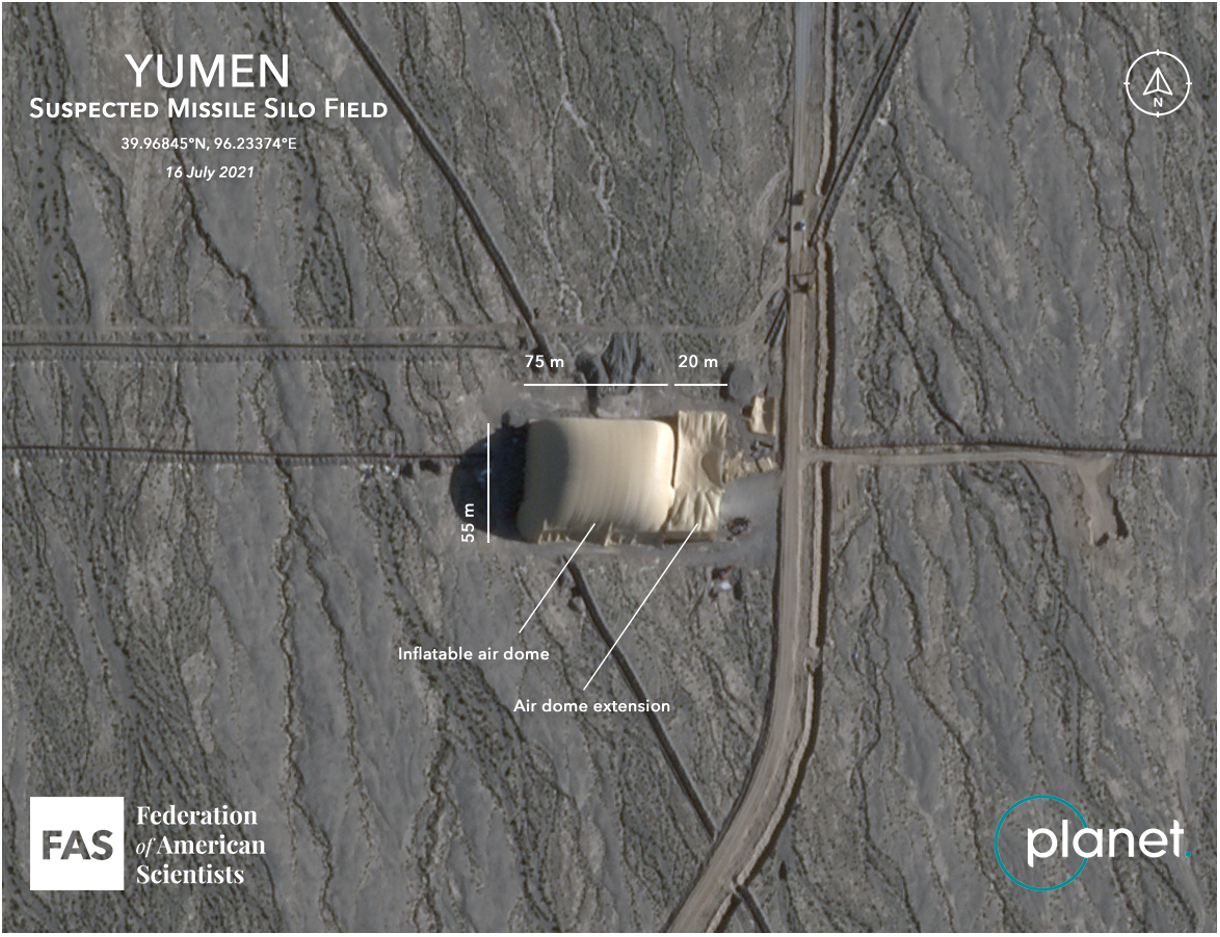
Some short dome shelters were extended. Image: © 2021 Planet Labs.
This reason for building longer dome shelters could indicate that silo excavation and construction activities required more space than the PLARF originally thought, and that they are now having to adjust for their newer sites. The estimated area of the longer domes is 4,925 square meters, excluding the approximately 300 square meters needed for the embedded vehicle airlock; this makes the total area slightly less than that of an NFL football field, which has an area of approximately 5,350 square meters.
- Round Shelters
At a third suspected missile silo field near Ordos is deploying a different type of inflatable air dome. Instead of the shorter and longer rectangular domes, the PLARF has opted to use round domes with circular bases. Interestingly, these circular domes appear to have several different types of patterns (see image below).

Round dome shelters at the suspected missile silo field near Ordos have more room but appear to serve the same purpose. Images © 2021 Planet Labs.
Other than the differences in shape and pattern, the domes appear to function the same way as the other sites. Similar to the longer rectangular air domes, the vehicle airlock appears to be embedded within the dome itself.
There are some potential advantages to these circular domes, compared to the rectangular domes used at Yumen, Hami, and Jilantai. A rounder shape is stronger than a rectangular one, and offers the maximum amount of internal space with the least amount of surface area. This means that less fabric is needed to create the structure, thus creating a potential cost savings. The estimated area of the round domes is approximately 4,725 square meters, excluding the 300 square meters needed for the embedded vehicle airlock.
- Solid Shelters
The PLARF has also constructed solid, rectangular structures to temporarily cover some of its suspected missile silo sites. In 2018, Catherine Dill noted that a solid 32m x 66m gable-roofed structure had covered a silo at Wuzhai before it was removed in December 2017. In 2019, Hans Kristensen’s discovery of the Jilantai missile training area included a solid structure with similar measurements covering a newly-constructed silo; in total, the first four apparent silos at Jilantai were built under solid shelters. In 2020, Scott LaFoy and Decker Eveleth also noted the presence of four high-bay structures with similar measurements covering previously-identified DF-4 ICBM launch sites at Sundian.
In addition to these sites, 11 identical solid structures have been erected at the suspected Yumen missile silo site (see image below). These structures––which were among the very first structures erected at Yumen between March and October 2020––are outliers for the entire complex, which is subsequently has filled entirely with shorter dome shelters that were deployed later in the complex’s construction period (see image below).
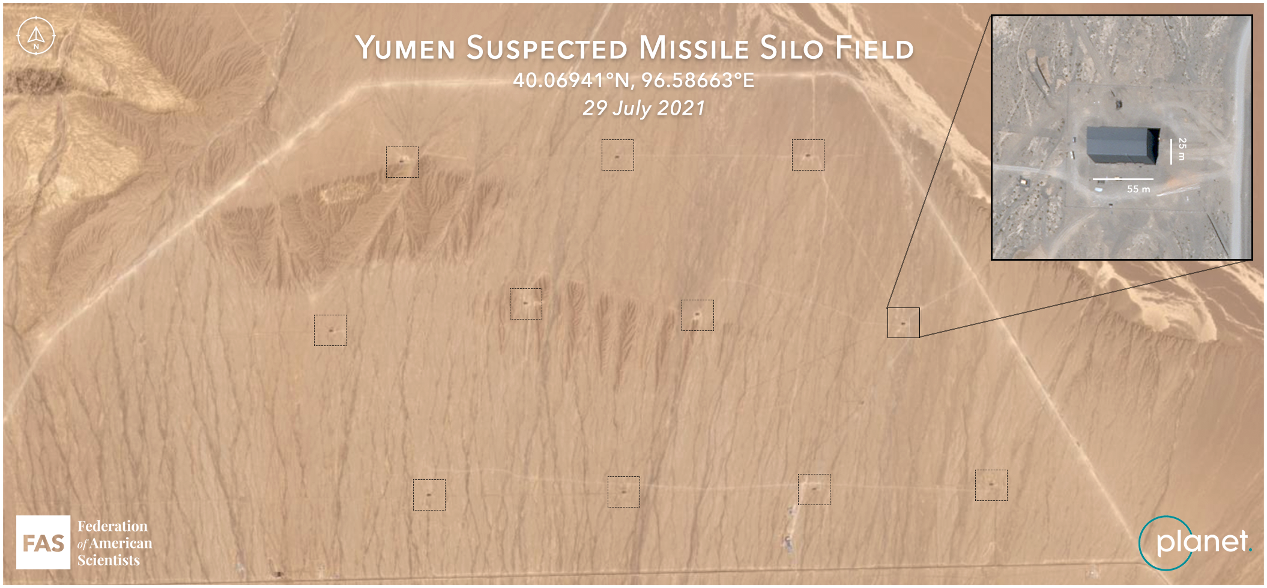
The first 11 shelters erected at Yumen were solid, like the first four at Jilantai. Click on image to full size. Image © 2021 Planet Labs.
What Is Underneath The Shelters?
Several shelters over suspected silo construction sites have now been removed, which allows us to better determine the possible function of the sites. The new satellite images show features that reaffirm that the sites appear to be silos in various stages of construction. A few satellite images taken at sites before the shelters were built already showed features strongly suggesting the sites were missile silos, and the first four sites at Jilantai are clearly silos. But with the growing number of shelters being removed, so far over 40, the evidence pointing to silo construction is in our assessment getting stronger.
Because silo construction at the PLARF training site near Jilantai began before construction at the three large missile silo fields, developments at Jilantai are likely precursors for events that will appear later at the other sites. One of the first four silos (39.76470°N, 105.53952°E) appears to show silo operations. Preparation of this site began in July 2019, and by early-August, satellite images showed excavation of a six-meter-wide deep hole inside a shallower 14–15-meter hole. The following month a shelter was built over the silo apparently to hide technical details from satellites. This was a solid shelter similar to the first 11 later constructed at Yumen. Once silo construction had been completed the shelter was dismantled while construction of access roads and command and control facilities continued. This summer, a Maxar satellite photo showed what appeared to be a missile loading operation at the site, and on October 29, a Planet Labs satellite photographed additional crane operations over the open silo. The silo is probably not yet operational.
The first four silos at Jilantai were covered by garage-like shelters. But in early 2021, dome-like shelters were erected over an additional 10 possible missile silos. These domes, or inflatable shelters, are identical or similar to the shelters over the vast majority of suspected silo sites at Hami, Yumi, and Ordos. In late-October, the dome shelters at Jilantai began to come down. A satellite image of one of these (39.72593°N, 105.52898°E) shows clear signs of a possible silo, first during the early stages immediately before the shelter was erected, and finally immediately after shelter was dismantled. Visible features include what appear to be a silo hatch, small auxiliary buildings, and ground markings from possible buried command and control cables or power lines. The other sites at Jilantai have the same features and dimensions.
The silo features are also clearly visible at Yumen, which began construction earlier than Hami and Ordos. So far, the shelters have been removed from at least 29 suspected silos at Yumen. The structures are very similar: an apparent silo hatch on an elevated dirt mound, with small auxiliary structures, a wide-turn access road presumably for use by missile transport and maintenance trucks. One of the apparent silo sites under construction at Yumen is shown below. Over the next several months, the remaining surface features will be completed.
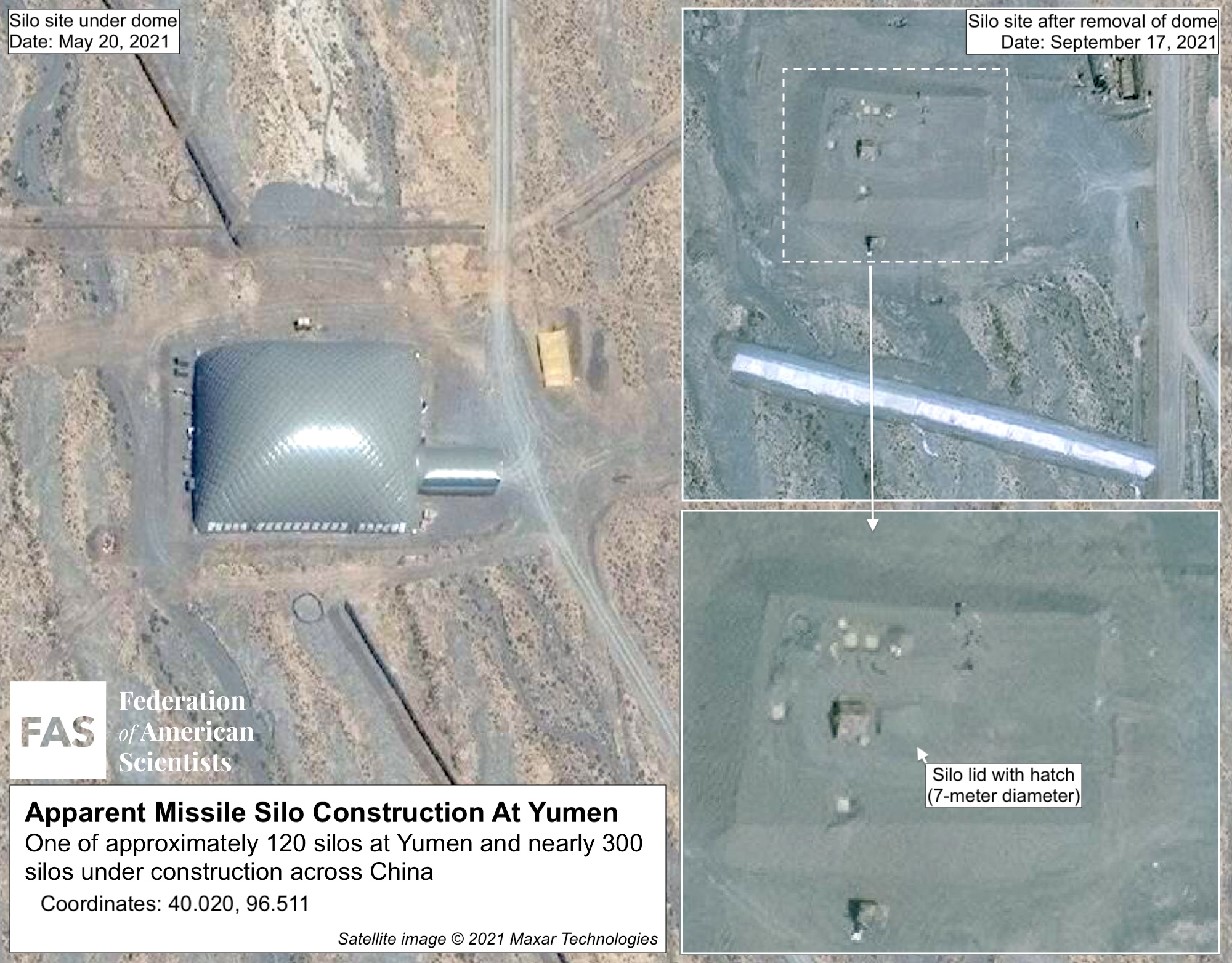
Suspected silos under construction at Yumen show features very similar to those observed at Jilantai. Click on image to view full size. Images © 2021 Maxar Technologies
Support Facilities
Operation of large missile silo fields requires extensive support infrastructure. This includes main base headquarters, technical support bases, missile and warhead support facilities, command and control infrastructure, electrical power supply, and roads. Many of the facilities under construction at the three suspected missile silo fields at Hami, Yumen and Ordos, as well as at the training site near Jilantai, appear intended to support such functions.
One of the most unique facilities under construction is a large complex that includes what appear to be three large parallel tubes embedded in trenches and connected to buildings via smaller tubes. Underground tunnels connect the three tubes, which might eventually be covered with soil. So far, this type of facility has been found at the Hami and Ordos missile silo fields (see image below), but not yet at Yumen. The function of these two facilities is unknown but could potentially be related to climate-controlled storage or handling of fragile missile and/or warhead components, or command bunker function. (Note: there is no evidence this is the case.)
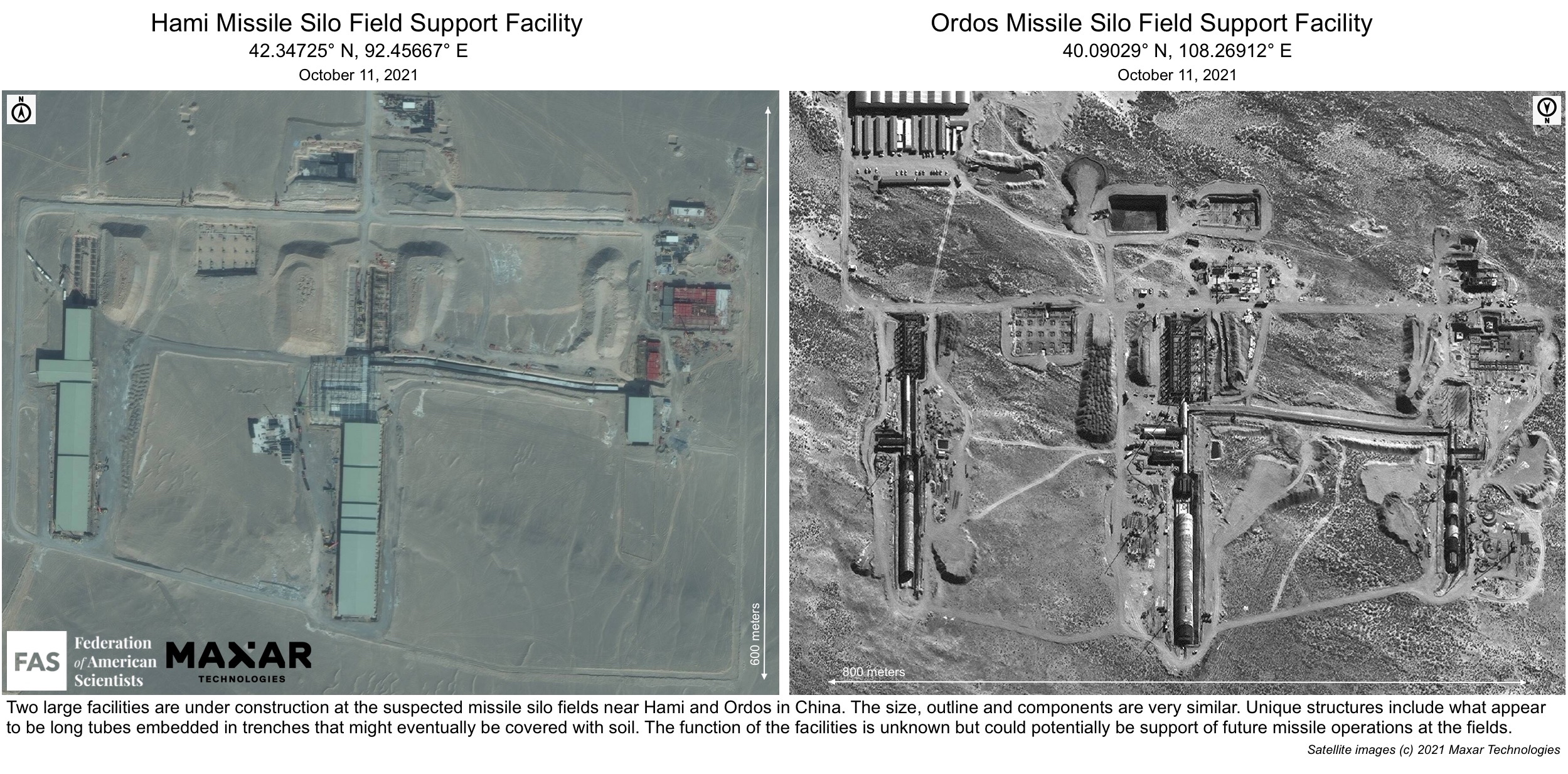
Large and unique support facilities are under construction at the suspected missile silo fields at Hami and Ordos. Click on image to view full size. Images © 2021 Maxar Technologies
Another unique facility so far seen only at Hami (42.2343°N, 92.897°E) includes a growing central complex in the mountains surrounded by what appear to be four tunnels into underground facilities. The tunnels are still under construction and show large amounts of excavation soil dumped nearby (see image below). The function of the facility is unknown but could potentially involve missile and/or warhead storage and management. Again, there is no evidence this is the case and is speculation at this point. The base-tunnel complex appears to be connected to the main missile silo grid via an underground cable. Sixty kilometers (37 miles) to the west (42.32163° N, 92.16282° E), at the other far side of the suspected missile field, is a similar facility with tunnels under construction.
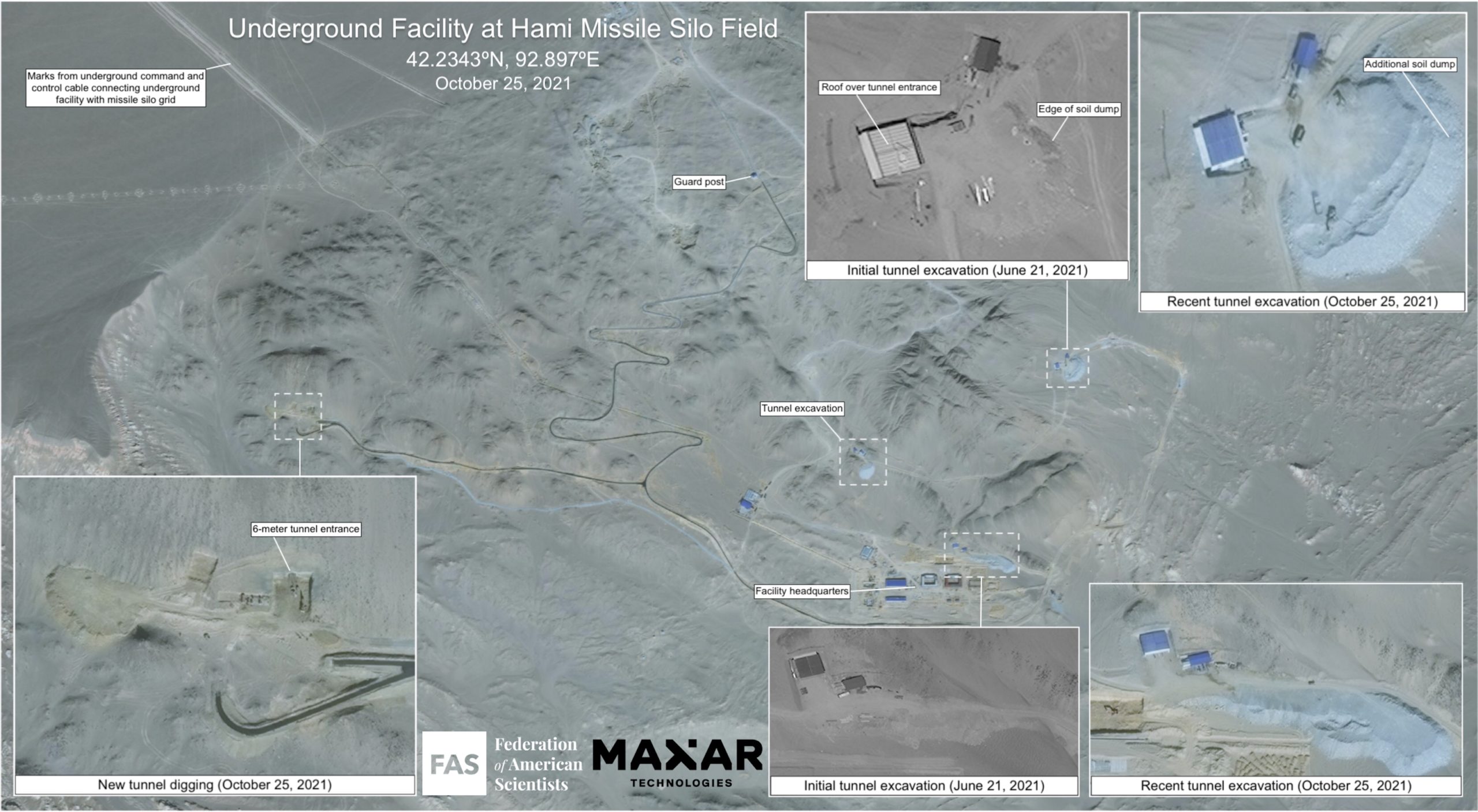
A large complex with several tunnels to underground facilities is under construction next to the suspected missile field at Hami. Click on image to view full size. Satellite images (©) 2021 Maxar Technologies.
There are also many other structures under construction that may be technical service facilities and launch control centers. Especially at Hami, we see construction of long lines of what may be powerlines intended to provide electrical power to the sprawling facilities. Finally, a number of larger and smaller construction camps and soil extraction sites are visible at all the suspected missile fields.
Interactive Maps
In order to help monitor and illustrate the construction of China’s suspected missile silo fields, the Federation of American Scientists has created an interactive map for each of the suspected missile silo fields at Yumen, Hami and Ordos (see example of Yumen below). Each map has a slider that allows the viewer to see how the construction of major facilities has progressed over time. These maps will be updated as construction continues. To access the maps, use these links:
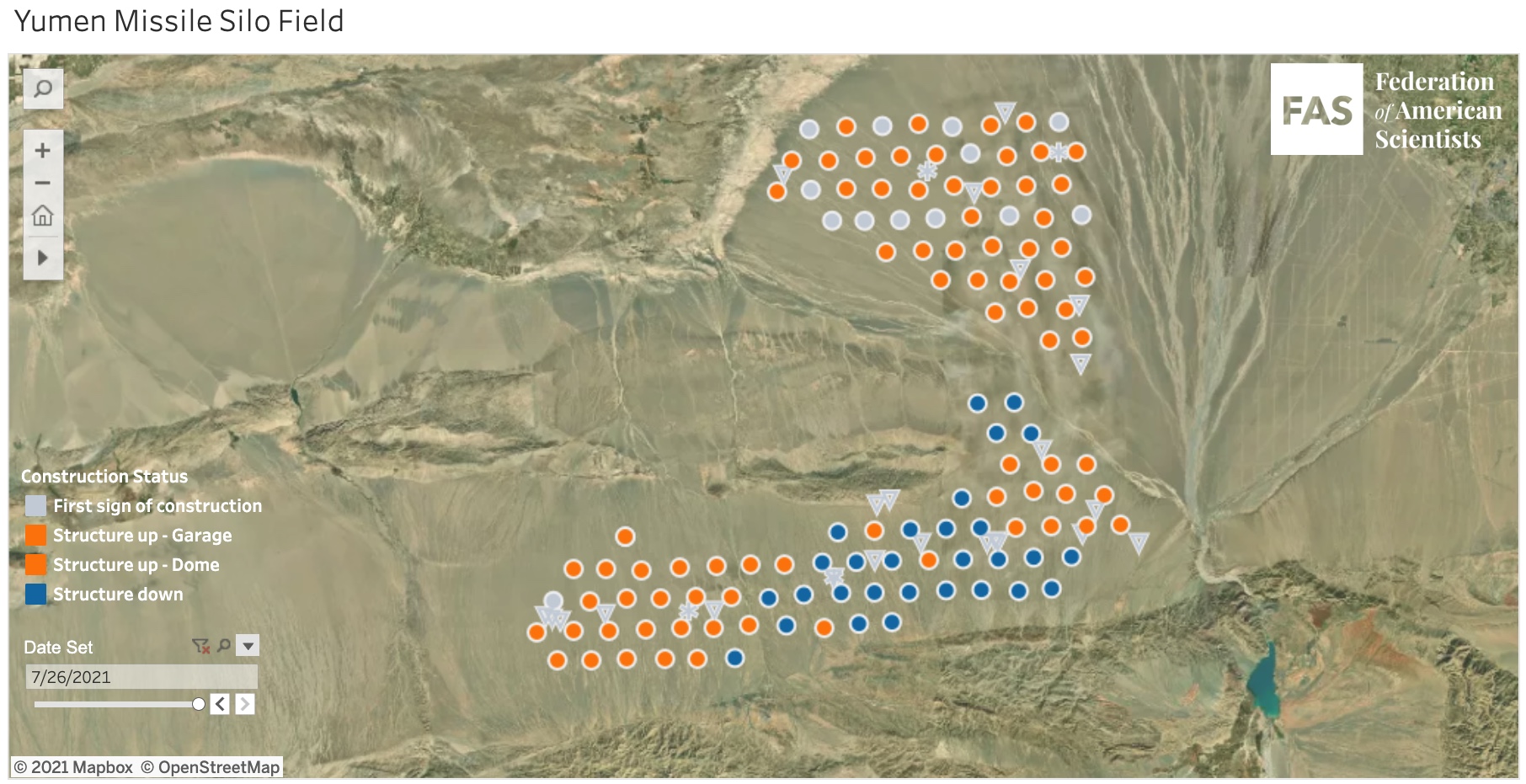
FAS is building three interactive maps to enable the public to monitor the construction of China’s three suspected missile silo fields.
Concluding Thoughts
The similarities of the structures and the construction activities at the Jilantai training area and the three suspected missile silo fields under construction near Yuman, Hami, and Ordos all show what appear to be a clear connection to the PLARF’s missile program. Early on, this connection was most visible at Jilantai, where commercial satellite imagery captured telltale semi-circle silo wall structures, silo hatches, and even a potential missile loading operation. With construction progressing at the larger missile fields at Yumen, Hami and Ordos as described in this article, we see strong indications in the satellite images of what appear to be construction of missile silos and support facilities.
It is notable that at this time, no other inflatable air dome complexes on this scale have been spotted at other sites in China. Some sites (for example: 40.18064° N, 107.53670° E) appear to have similar (but much shorter) spacing patterns to those seen at the suspected silo fields; however, at higher imagery resolutions it becomes clear that those structures are not dome shelters or silos, but are in fact much smaller and very different structures for windmills. It is potentially possible that some windmills will be constructed in between the apparent silos; there is some evidence of that at Yumen. We note that some US ICBM silos are also in close proximity of windmills (for example: 40.8222, -104.0505); this does not appear to interfere with silo operations but can effect helicopter operations in the area.
Although we are increasingly confident that the facilities we describe are related to the PLARF’s missile program, it is also important to exercise caution and avoid confirmation bias––particularly if there are additional relevant sites out there that have not yet been spotted on commercial satellite imagery. Nor do we know what China plans to load into the apparent missile silos or how many of them will eventually be armed. The Chinese government has not yet officially confirmed or denied that the facilities are missile silos. But U.S. military officials appear to have confirmed that the reported missile silo fields are part of China’s nuclear modernization program. And based on the features we can examine on the new satellite images, we are increasingly confident that the facilities are indeed missile silos and support facilities under construction.
For China, this is an unprecedented nuclear buildup. We and others have remarked that it raises questions and uncertainty about China’s minimum nuclear deterrent and policies. On the other hand, even construction of large number of silos may not necessarily reflect a change in the basic role the Chinese leadership attributes to its nuclear forces. For example, China could potentially still retain its no-first-use policy. The apparent missile silo fields are still many years away from becoming fully operational and it remains to be seen how China will arm and operate them.
It is important that the buildup does not further increase nuclear competition and fuel worst-case planning in other nuclear weapon states, although we fear those are likely outcomes. These developments will feature prominently in the Biden administration’s ongoing Nuclear Posture Review and we urge the administration not to overreact but pursue conversations with the Chinese government to develop measures to reduce tension and increase transparency.
The reason is obvious: Although China has so far rejected limits on its nuclear forces by arguing that “Countries with the largest nuclear arsenals [Russia and the United States] have special and primary responsibilities in nuclear disarmament,” the size of the Chinese missile silo program – combined with the other elements of China’s nuclear modernization – could bring China into that category in the not too distant future. With approximately 300 apparent silos under construction – a number that exceeds the number of ICBM silos operated by Russia – and an additional 100-plus road-mobile ICBM launchers, China’s total ICBM force could potentially exceed that of either Russia and the United States in the foreseeable future.
This worrisome development may ironically also create new opportunities for arms control discussions and potential agreements. That is, if there is the political will to pursue them. With the review conference of the nuclear Non-Proliferation Treaty approaching early next year, this would seem to be a good time for the large nuclear powers to demonstrate that will.
Background information:
- China’s nuclear missile silo expansion: From minimum deterrence to medium deterrence (2021)
- China Is Building A Second Nuclear Missile Silo Field (2021)
- SIPRI Yearbook World Nuclear Forces (with China section), 2021
- China’s Expanding Missile Training Area: More Silos, Tunnels, and Support Facilities (2020)
- New Missile Silo And DF-41 Launchers Seen In Chinese Nuclear Missile Training (2019)
- Status of world nuclear forces
This publication was made possible by generous support from the John D. and Catherine T. MacArthur Foundation, the New Land Foundation, the Ploughshares Fund, and the Prospect Hill Foundation. The statements made and views expressed are solely the responsibility of the author.
While it is reasonable for governments to keep the most sensitive aspects of nuclear policies secret, the rights of their citizens to have access to general knowledge about these issues is equally valid so they may know about the consequences to themselves and their country.
Nearly one year after the Pentagon certified the Sentinel intercontinental ballistic missile program to continue after it incurred critical cost and schedule overruns, the new nuclear missile could once again be in trouble.
“The era of reductions in the number of nuclear weapons in the world, which had lasted since the end of the cold war, is coming to an end”
Without information, without factual information, you can’t act. You can’t relate to the world you live in. And so it’s super important for us to be able to monitor what’s happening around the world, analyze the material, and translate it into something that different audiences can understand.